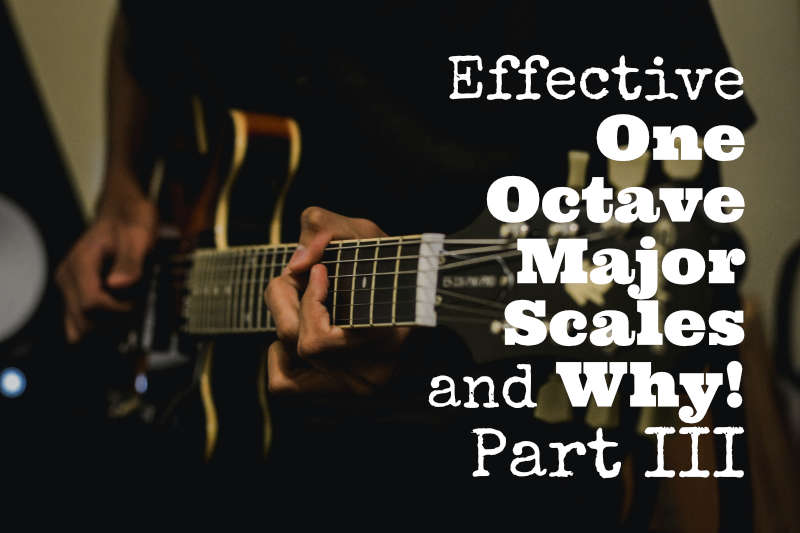April 21, 2021 by Klaus Crow

Today you are ready to take on Part III of the effective one-octave major scales. We’re going to climb up the strings and into the higher regions of the scale. This will make the scale patterns more comfortable to play because it’s easier to reach and press the thinner strings.
Moreover, most guitar solos take place on the highest strings of the guitar, so these scale patterns are crucial to get under your soloing fingers.
Recap One Octave Major Scales
For those of you who just stepped into Part III of the One-Octave major scale series and missed out on Part I and Part II, here are the reasons you want to learn this:
The one-octave major scale makes it easy to recognize the shape, the structure, the notes and the intervals of the scale. One-octave scales are a perfect start for beginners and will create new insights for intermediate guitar players. The major scale is the mother of all scales and is the cornerstone of everything in guitar playing.
Starting from the Root Note on the D-string
Today we are learning three major scale shape/patterns with the first (root) note starting on the D-string (4th string).
Tip: Learn and memorize the notes on the D-string so you can instantly recognize the key of the scale when you want to move the scale up or down the fretboard.
Major Scale Fingering
For the major scale shapes I’ve notated the fret-hand fingering. The numbers next to the notes on the note staff right above the tablature indicate the fret-hand fingers:
| 1 = index | 2 = middle finger |3 = ring finger | 4 = pinky |
The numbers in the yellow neck diagrams also indicate the fret-hand fingering. The neck diagrams clearly show the shape and pattern of each scale. Learn to visualize and memorize the shape of each pattern.
Note: Apply alternative picking playing the scales shapes.
Practice in every Key
Once you got the G major scale shapes under your fingers learn the pattern in different keys or in every key following the cycle of fourths.
Let’s enjoy the lesson!
MAJOR SCALE SHAPES – ROOT NOTE STARTS FROM THE 4TH STRING
G MAJOR SCALE fingering / shape / pattern #7


G MAJOR SCALE fingering / shape / pattern #8


G MAJOR SCALE fingering / shape / pattern #9


One Octave Major Scale Assignments Part III
- Learn each scale shape thoroughly using alternate picking.
- Visualize and memorize the shape of each scale pattern in your mind.
- Learn the notes of the D-string.
- Play the shapes in different keys or through the cycle of fourths.
- Play the scales along with a metronome gradually increasing the bpm.
- Re-practice the one-octave major scale patterns of Part I and II.
- Try to create some melody with the new scale patterns.
- Bonus: Learn the scale inside out with extra exercises
Start making the small steps today that will accumulate and improve your playing now and overtime. It’s that easy and it works!
P.S. If you’re ready for the final lesson move on One-Octave Major Scale series – Part IV
Pssssst.
You can also follow me on Instagram. Don’t tell anyone.
Kindly share your awesome comments below. You rock! ~ Klaus Crow
Thanx.
Eagerly waiting for the final lesson of these series.
Hi Sam,
Enjoy the lesson. Part IV coming up.
Make sure you got these under your fingers ;)
Best,
Klaus
Klaus:
Thanks for being the first to show people to think in one-octave sections of the fretboard rather than those overwhelming “5 pattern” major, minor, pentatonic, etc. patterns that cover all six strings and leave every scale incomplete at one end or the other.
Not only are they bewildering, but to mindlessly practice those multi-scale boxes is just plain BORING! Better to learn 1-octave areas of the fretboard (and a little music theory, like keys, as well as the names of every fret on the fretboard, e.g., A#/Bb, etc.) so you can see how unnecessary those cumbersome dot-filled diagrams are.
Better yet, just start learning some songs just at the edge of your technical ability so you can see, feel, and hear how all those boxes were used to create a musical STORY. If you don’t have anything to say musically, then don’t bother with scales at all.
Another thing, if you really have faith in those 6-string across-the fretboard scale patterns, then learn to play ALL 12 KEYS in the same pattern instead of working your way up and down the neck to play in various keys, whether it’s chromatically, or relative major and minor pairs, or the circle of fifths, the circle of fourths, etc.
In other words, if you’re going to go the 6-string scale route, then learn the hell out of your instrument so you can see how those abstract concepts were actually used by the greats in whatever style(s) you’re into to TELL A STORY.
Hi Allen,
Thanks for your comment.
The one-octave major scales are indeed easier to get your head around, especially when you’re just diving into scales,
but even for intermediate guitar players who have always played two-octave scales it’s good to practice these as well,
and become aware of how the scale is structured. These lessons will fit new pieces to the puzzle and roadmap of major scales becomes clearer.
Best,
Klaus Crow
Thank you, Klaus. I am an advanced beginner and your One Octave scale method has opened some important doors to me.
Hi Claudia,
That’s great! Doesn’t it feel good to move ahead and learn new things?
Thanks Claudia for reaching out and have a great guitar practice.
Best,
Klaus Crow